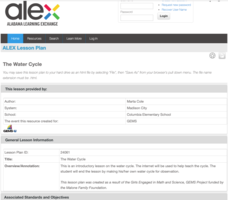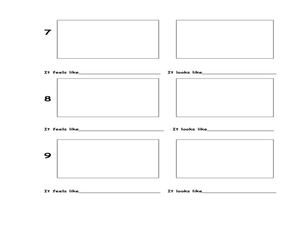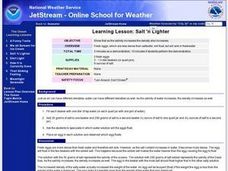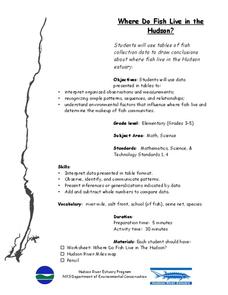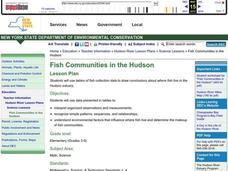Curated OER
Science - How are Animals Grouped?
In these categorizing animals worksheets, students complete 20 true or false statements about animal groups. Students then classify the animals in the box into the correct column. Students write the letter of the correct answer for the...
Curated OER
Wetland in a Pan
Students examine wetlands and what the effects of destroying them will do. In this wetland lesson students relate the importance of wetland functions to their own needs.
Alabama Learning Exchange
The Water Cycle
Students explore the water cycle. In this earth science lesson plan, they read the book Water Dance by Thomas Locker and use an interactive whiteboard to review the water cycle with an interactive website.
Curated OER
Salt Marsh Plants and Animals
In this salt march plant and animals worksheet, students read descriptions of animals, then match each to its picture. Students then read about tidal animals and choose which animals in picture are most likely to be in a salt march at...
Curated OER
Water: A precious resource
In this water activity, students watch a video on water, read a passage, complete sentences, write vocabulary words, and write a paragraph. Students complete 5 activities total.
Curated OER
Layering of Water
Students examine what happens when different types of water meet. In groups, they participate in an activity in which they combine different percentages of salt, fresh and brackish water and record their observations. They let the...
Curated OER
A Salty Experiment
Students study salty and fresh waters. In this harbor estuary lesson plan students complete a lab activity on salinity and describe what happened.
Curated OER
The Floating Golf Ball
Fourth graders discuss density. In this floating golf ball lesson plan students complete a lab activity on density while working in groups.
Curated OER
Water Density Boundaries
Students create observable layers in water that represent a separation based upon density differences. They model density boundaries using differences in temperature and salinity. They, in groups, perform a meaningful experiment...
Curated OER
Water Density and Stability Lab
Learners observe how different water densities and salinity control the depth at which different water masses occur. Submarines are used as a case study. This is a well-designed with an excellent worksheet.
Curated OER
Salmon Life Cycle
In this life cycle worksheet, students fill in the blanks with words about the life cycle of a salmon. Students complete 20 words about the life cycle.
Curated OER
Exploring Marine Objects
Learners identify the sources of water on Earth. In this life science lesson, students list the different plants and animals that live in the ocean. They explore marine objects in the lab and draw them.
Curated OER
Rivers for the Common Good
Students explore what effects improper waste disposal and water pollution have on the water cycle. They explore how philanthropic acts can help protect the water cycle and keep our water and planet clean.
Curated OER
Using A Winogradsky Column to Analyze Microbial Communities
Pupils use easily obtained materials to study ecological succession in a microbiological community. They collect water samples from outdoor sources in plastic bottles to observe and record changes.
Curated OER
Water Systems
In this water systems worksheet, students refer to their textbook to complete questions about the amount of water on earth and the portion of water in various forms. Students review porosity, permeability, and water table. This worksheet...
Curated OER
Water Quality Monitoring
Students comprehend the four parameters of water quality. They perform tests for salinity, dissolved oxygen, pH and clarity or turbidity. Students comprehend why scientists and environmental managers monitor water uality and aquatic...
Curated OER
Learning Lesson: Salt 'n Lighter
Pupils participate in a demonstration showing that as salinity increases density increases as well. They also examine the different densities of air. They discuss the amount of water displaced by large ships.
Curated OER
Tracking the Salt Front
Students manipulate Hudson River salt front data from October 2004 -
September 2005 to locate the high and low points of the salt front for each month, They determine the range for each month, determine the modal range for each month,...
Curated OER
Locating the Salt Front
Learners use Hudson River salinity data to create a line
graph that shows the location of the salt front, and use math
skills to explore how this location varies over time. They use the graph to estimate the location of the salt front...
Curated OER
Where Do Fish Live in the Hudson?
Learners explore the environmental factors that influence where fish live and determine the makeup of fish communities in the Hudson. They interpret guided observations and measurements to assess patterns, sequences and relationships.
Curated OER
Fish Communities in the Hudson
Students use tables of fish collection data to draw conclusions about where fish live in the Hudson Estuary. Given available data they interpret organized observations and measurements and recognize simple patterns, sequences, and...
Curated OER
Animal Life Histories Derived From Morphology
Students learn the mechanisms of natural selection by deducing information from the physical appearance of the animal.
Curated OER
NOAA Research Project
Students research any topic relating to the National Oceanic and Atmospheric Administration (NOAA) research cruise that Mrs. Richards be participating in.
Curated OER
Black Pearls
Students examine where pearls come from and where mollusks are found. They discover how pearls are formed in nature and how they are they made by humans. They use ordinary oyster shells to examine mother of pearl.




